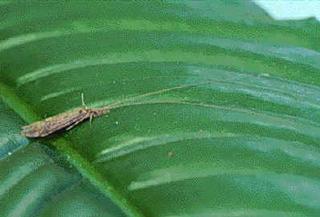 |
Order
- TRICHOPTERA
(Greek, thrix = hair; pteron = wing)
Common Name: caddisflies
Distribution: Cosmopolitan
Description
Adult caddisflies are soft bodied and very much resemble moths. The order
Trichoptera is closely related to the order Lepidoptera. The mature
insects have large compound eyes with two or three simple eyes (ocelli).
Antennae are long and composed of short, straight segments (filiform).
Mouthparts are reduced and adults are incapable of consuming solid food.
Adults can ingest nectar or water but do not often feed if at all. Two
pairs of wings are held at rest in a position which resembles the two
sloping sides of a house roof. The wings may be hairy or scaled. Body
colour is grey or brown and resting insects are extremely well
camouflaged.
Larva
The larval stages are aquatic. Eggs are laid in sticky masses attached to
twigs or rocks in the water. On hatching the larva may either build a case in
which it lives or remain naked and build a conical net which is used to capture
food. Case building larvae are mostly vegetarians and feed on detritus or may
graze upon water plants. But others prey on small fresh water animals. Net
building larvae are purely carnivorous. Net spinners are restricted to flowing
water, but case makers frequent still water. On maturity, the larva pupates
either within a cocoon or only as a pupal case protected by silk strands through
which water flows. The pupa has free legs and large mandibles with which it
chews through the cocoon or silk and swims to the surface. The pupa then splits
and is used by the emergent adult as a floating platform.
Members
Caddisflies.
Food
Caddisflies feed on fresh vegetative material or detritus. Small freshwater
animal life will also be consumed.
Importance
Caddisflies are very important as a food resource for fish in freshwater
streams.
|